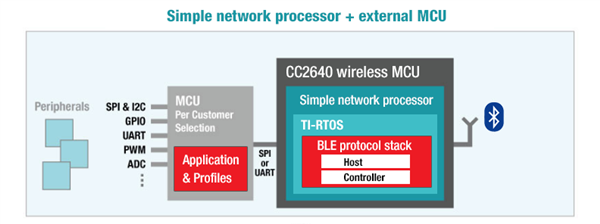This page will describe how to use the CC2640R2F LaunchPad as a Bluetooth Low Energy (BLE) wireless network processor. A wireless network processor (NP) setup is a dual MCU solution, where an external MCU such as the MSP432 manages the Bluetooth application layer (Profiles and Services) and sends commands to the CC2640R2F LaunchPad BLE wireless MCU over a serial interface. In the NP configuration, the BLE Host and Controller protocol stack elements reside on the wireless MCU. Adding BLE to your existing MCU quickly enables IoT capability in an existing closed/cabled design.
Note
A Network Processor is not the same as an HCI LE Controller-only configuration, such as supported by CC2564 and WiLink8 controllers. The CC2640R2F LaunchPad wireless MCU does not support a standalone LE Controller-only configuration since the TI BLE Stack (Host and Controller) executes on the CC2640R2F LaunchPad.
Serial Interface (NPI)¶
The serial connection between the Application Processor (AP) and Network Processor is handled through TI’s Network Processor Interface (NPI). NPI is compile time configurable and currently supports UART and SPI. There are two versions of NPI. While they share a lot of similarities, there are important differences that must be accounted for when developing a dual MCU solution.
To learn more about the NPI interface that each NP solution uses, please see Network Processor Interface (NPI)
TI BLE Wireless Network Processor Example Projects¶
TI offers two Wireless Network Processor example projects in the BLE-Stack to quickly add BLE to your existing MCU/SoC architecture. To assist with finding the right NP application for your Bluetooth Low Energy (BLE) design, the table below shows some of the benefits and trade offs associated with each NP example. These sample projects can be found under the examples folder in the BLE-Stack SDK.
| Name | Description | Interface | Advantages | Disadvantages |
| SimpleNP (SNP) | An easy to use BLE network processor solution and default SW offering. HCI layer is abstracted away, interface with NP via remote procedure calls. | Unified NPI | Only a handful of commands are required to start sending data over BLE. Most Bluetooth related processing is handled by the SNP, freeing up the application processor (AP) for other tasks. Lightweight interface library for the Application MCU (SAP) is provided in source. LE Security, including LE Secure Connections is supported. | Peripheral + Broadcaster GAP role support only. |
| HostTest | A network processor solution that interfaces with TI’s controller and host using HCI and HCI Vendor Specific commands | NPI | Configurable, supports all controller and host roles and features from the SDK. Includes support for performing all regulatory testing (i.e., FCC & RF-PHY) | Requires external MCU to implement the TI Vendor Specific HCI layer, handling all commands and events generated |
Simple Network Processor¶
SimpleNP is for developers who want to easily add a simple and reliable BLE interface/subsystem to an existing MCU. Using the BLE-Stack simple network processor mode allows for quick and easy addition of secure Bluetooth Low Energy wireless connectivity to any embedded system by providing a simple API (SAP) to drive the CC2640R2F LaunchPad wireless MCU from a host microcontroller. The complete Bluetooth Low Energy controller, host and a simple network processor interface layer resides on the CC2640R2F LaunchPad wireless MCU, while a light network processor driver library resides on an external MCU connected to CC2640R2F LaunchPad device via a standard serial connection. Developers can leverage this mode to reuse years of technology developed on embedded MCUs and easily add wireless connectivity to their system without going through the learning curve of Bluetooth Low Energy wireless protocol and software stacks. All SNP & SAP project code is provided in full source form (except for the core BLE Stack), so the developer can easily port or customize these projects to work with other application processor MCUs.
To get started with the simple_np, please download the MSP Bluetooth Plugin and do the Bluetooth SDK Plugin Lab of the MSP432P4 SimpleLink Academy
Host Test¶
Developers should consider HostTest for developing a dual-MCU BLE solution if they need to support the Central or multiple GAP roles and are familiar with the HCI and Vendor-Specific (VS) HCI protocol implementation.
A combination of HCI and VS HCI commands/events form the interface to the HostTest app from the application processor. HostTest uses NPI (non Unified version, see link above) to send and receive raw HCI-formatted commands over the serial interface, and pack/unpack them for the BLE stack to process. At the NPI layer all HCI packets are queued up asynchronously. NPI primarily serves to pack and unpack the HCI data structures into byte arrays, all HCI packets are sent in a FIFO manner.
The HCI/HCI Vendor Specific interface is described in the TI Vendor Specific HCI Guide. See this document for more information about the TI Vendor Specific (VS) HCI interface.

